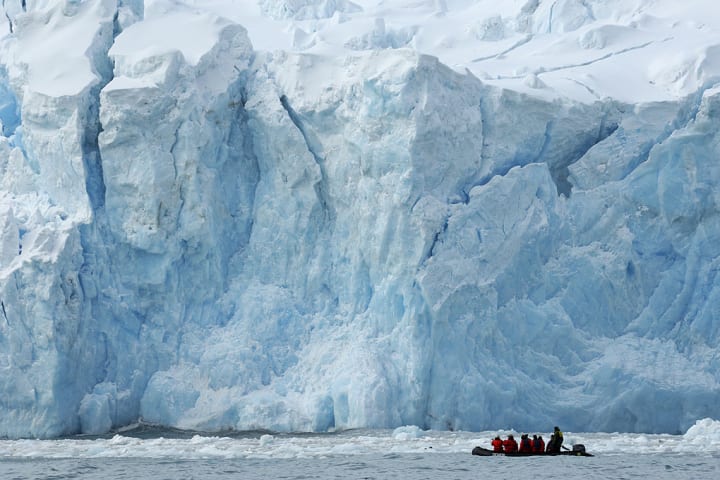Antarctica is one of Earth’s last largely pristine places. A decade ago, about 33,000 tourists visited the southern continent each year; today, that number has more than doubled to over 74,000 [PDF]. But with them come non-native species that can disrupt fragile ecosystems, further damaging highly trafficked areas and increasing pollution.
To lessen visitors’ impacts in Antarctica, scientists and polar tour operators are balancing the risks to the delicate environment with the need to foster stewardship of the remote region—by engaging the tourists themselves.
A 2012 study found that each Antarctic visitor distributes an average of 9.5 non-indigenous seeds across the continent. However, these hitchhikers aren’t limited to those clinging to humans; more recent research found that small marine organisms from all over the world catch rides on ships bound for Antarctica. These may not seem like big problems—in other oceans, commercial cruise liners leave oil, plastic waste, and sewage in their wake—but any invasive species has the potential to disrupt a habitat in which it has no natural predators. Over time, foreign plants and animals brought by humans can become established in their new environment and crowd out the endemic species [PDF].
The International Antarctic Association of Tour Operators (IAATO), founded in 1991, promotes “environmentally responsible” tourism to the frozen continent. That includes hypervigilant efforts to stop the arrival and spread of non-native species and incorporating the latest science into their tourism policies. Such proactivity and foresight are critical for the continent’s health and their own bottom line.
IAATO and its affiliated research scientists are now encouraging these tourists to have a positive impact on the South Pole—and the entire planet.

“Instead of passively telling visitors about the research that goes on in Antarctica, we can get them to participate through citizen science programs,” Allison Cusick tells Mental Floss. “It’s an immersive experience.”
Cusick , a Ph.D. candidate in biological oceanography at the Scripps Institution of Oceanography, co-founded the FjordPhyto initiative to investigate how melting glaciers are affecting phytoplankton communities along the western Antarctic Peninsula. She and her colleagues have enrolled more than 4000 Antarctic tourists as citizen scientists to sample the waters and gauge the productivity of the marine ecosystems while they’re on their bucket-list trips.
FjordPhyto collaborates with the Polar Citizen Science Collective (PCSC), a clearinghouse for scientists wanting to launch citizen science projects at the poles and tour operators who want to offer the experience to their guests. In addition to FjordPhyto, the PCSC has helped polar researchers connect with citizen science volunteers for studies ranging from cloud surveillance to marine mammal identification. It’s a mutually beneficial relationship. “With citizen science, we researchers can expand our scope of questioning, and it keeps people curious about the world around them,” Cusick says.

Antarctic visitors have a role after returning home as well. IAATO’s members encourage their clients to become “Antarctic ambassadors” by sharing stories about their experiences there and advocating for conservation.
It’s not just about giving visitors the trip of a lifetime, Daniela Cajiao tells Mental Floss, “but how we can make these life-changing experiences last.” Cajiao, who recently earned a doctorate at the Universidad Autónoma de Madrid, co-authored a study earlier this year that examined what happens after Antarctic tourists concluded their visits. She discovered that, while guides show tourists that they have a role in supporting policies protecting the fragile landscape, the efforts don’t always translate to environmental actions.
Today’s Antarctic visitors are attuned to the social aspects of exploration and more likely to learn from interactive activities, like citizen science initiatives, than on-board lectures, Cajiao explains. Her study suggests that citizen science projects and adventures tailored to these attitudes are correlated with tourists acting for the environment after their vacations end. This is extremely important in the context of Antarctic conservation, she says; action, not thoughts or feelings, is what will help preserve the polar ecosystem.
“Why do we care about this giant ice desert?” Cusick asks rhetorically. “Because it’s crucial for the health of the entire planet.” And caring about what happens at the South Pole shouldn’t be limited to scientists., experts say.
When we’re inspired to learn about a place and experience its beauty, we form a deep connection to something bigger than ourselves. The key is instilling a sense of wonder so profound it stays with Antarctica’s tourists long after they return home.
